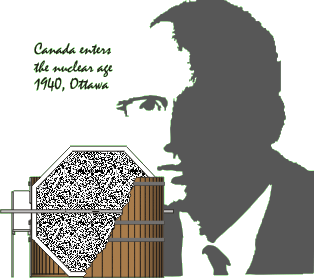|
Published in the December 2006
issue of the Canadian
Nuclear Society Bulletin, Vol.27, No.4.
It's a Wonderful Half-Life
by Jeremy Whitlock
True to Canadian form, the major nuclear achievements of this country are about as familiar to its citizenry as the name of its second Prime Minister (or third, or fourth, or fifth…).
Of course everyone knows that we're famous for inventing the heavy-water reactor, even if that's not quite true. Almost as many know of our traditional status as a nuclear weapons-free country. Also untrue.
A good number of other things are quite demonstrably true, however, so in the spirit of stimulated nationalism that has held this country together for almost 140 years, the Special Patriotic Subcommittee of the Society for the Recognition of Nuclear Scientists and Engineers as a Nation Within a Unified Canada presents herein (after much debate) the "Top Ten Canadian Nuclear Achievements", in no particular order of importance:
-
Rutherford Was Here: Long before joining the exalted ranks at the Cavendish, Lord Rutherford first proposed the concept of radioactivity, and coined the term "half-life", during nine prolific years at McGill University. This earned Rutherford a well-deserved Nobel Prize in 1908, albeit one that this is seldom associated with Canada since he had departed these shores a year beforehand.
-
First Graphite Nuclear Pile: Before the Manhattan Project and Fermi, there was Laurence. Starting in 1940, PEI-born George C. Laurence, while heading the National Research Council's radiation laboratory, built a 10-tonne graphite nuclear reactor in his spare time, under high security at the Sussex Drive laboratories in Ottawa. Although failing to achieve a self-sustained chain reaction, it was a world first and a precursor of Canada's major wartime role to follow.
-
First Nuclear Reactor Outside the U.S.: By the end of World War II Canada hosted the world's second-largest nuclear infrastructure, including the only operating reactor outside the U.S. Designed, built, and commissioned in less than a year at Chalk River, ZEEP was a low-power heavy-water reactor initially intended to test the instrumentation, materials, and physics of the behemoth NRX reactor under construction next door. It gracefully retired in 1970 and is currently displayed at the Science and Technology Museum in Ottawa.
-
First Large-Scale Research Reactor: When it started up in July 1947 NRX was the biggest, baddest research reactor on the planet. Designed by the NRC's wartime Montreal Laboratory, NRX surpassed all expectations and operated for the next 45 years. It made Chalk River the "Place to Be" for nuclear and solid-state physics for many years, and launched Canada's radioisotope industry. Among its achievements was John Robson's 1951 determination of the half-life of a free neutron (approximately 13 minutes: fortunately much longer than the fraction of a millisecond they last in a power reactor).
-
First Cobalt Cancer Therapy: In 1951 two parallel Canadian teams developed the world's first cobalt cancer "beam therapy" units. In October Roy Errington's team from Eldorado Mining and Refining treated the first patient in London, Ontario. Harold Johns' team followed less than two weeks later in Saskatchewan.
-
First Recovery from a Major Reactor Accident: The 1952 partial core rupture in NRX was a classic case of misfortune breeding opportunity. The post-mortem of the event spawned several new fundamental concepts in reactor safety, and made Canada a leader in the field. The reactor itself became the first to be totally refurbished and was restarted a remarkable 14 months later, with upgrades that allowed it to operate at higher power.

-
First On-Power Refuelling of a Large Reactor: Chalk River's NRU reactor regained the research-reactor limelight for Canada when it started up in 1957. Among its engineering distinctions was the first on-power refuelling of a large reactor, using a double-barreled flask that conceptually finds itself in the fuelling machines of CANDU reactors today. NRU continues to serve science and industry as it approaches its 50th birthday.
-
First Nuclear-Weapons-Capable Country to Renounce the Capability: At the close of WWII Canada was one of three countries on the planet with atomic weapons capability, but (unlike Britain and the U.S.) the only one to pass in favour of peaceful applications alone. Canada's leadership in global non-proliferation included a significant role in the formation of the UN's global watchdog, the International Atomic Energy Agency (IAEA).
-
First Computer Control of a Power Reactor: Solid-state electronic computing was only four years old in 1962 when the unprecedented decision was made to include limited digital control in the design of the Douglas Point CANDU prototype. The bar was raised again when the Pickering station became the first in the world to be totally controlled by a digital computer.
-
Multiple "Firsts" in Particle-Beam Physics: From Brockhouse's Nobel-winning Triple-Axis Neutron Spectrometer in the mid-1950s, to Bigham et al's Superconducting Cyclotron in the mid-1980s, Chalk River blazed a trail of ingenuity in the science of subatomic particles. That trail includes the world's first "Tandem" accelerator in the 1950s, and a cornucopia of custom instrumentation which set the standard - including the first lithium-drifted germanium detectors (for many years the workhorse of gamma spectrometry), developed by Ewan and Tavendale at Chalk River in the 1960s.
|